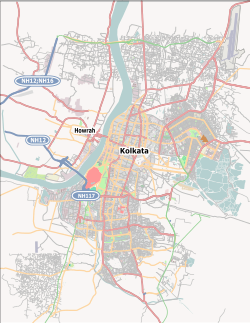
Kolkata is the capital and largest city of the Indian state of West Bengal. It lies on the eastern bank of the Hooghly River, 80 km (50 mi) west of the border with Bangladesh. It is the primary financial and commercial centre of eastern and northeastern India. Kolkata is the seventh most populous city of India with an estimated city proper population of 4.5 million (0.45 crore). It is the centre of the Kolkata Metropolitan Region, one of the most populous metropolitan areas in the world with a population of over 15 million residents. Kolkata is the de facto cultural capital of India and historically and culturally significant city in the historic region of Bengal. It is the second largest Bengali-speaking city in the world. It has the highest number of Nobel laureates among all cities in India.

The Battle of Plassey was a decisive victory of the British East India Company, under the leadership of Robert Clive, over the Nawab of Bengal and his French allies on 23 June 1757. The victory was made possible by the defection of Mir Jafar, Nawab Siraj-ud-Daulah's commander in chief. The battle helped the British East India Company take control of Bengal in 1772. Over the next hundred years, they continued to expand their control over vast territories in rest of the Indian subcontinent, including Burma.

Howrah is a very important and densely populated suburb of Kolkata in Indian state of West Bengal. Howrah City is located on the western bank of the Hooghly River of Kolkata Metropolitan Area. Administratively it lies within Howrah district, and is the headquarters of the Howrah Sadar subdivision. Howrah is an important transportation hub of Kolkata, West Bengal and its neighbouring states like Odisha, Bihar, Jharkhand and gateway to old CBD (Dalhousie) of Kolkata. Howrah railway terminal is the largest railway station of India which serves trains across India.

The Hooghly River or popularly called Ganga or Kati-Ganga in the Puranas, is a river that rises close to Giria, which lies north of Baharampur and Palashi in Murshidabad. It is the western distributary of the Ganges. The main course of the Ganges then flows into Bangladesh as the Padma. A man-made canal, built in the 1960s and early-1970s at Farakka, connects the Ganges, flowing through Malda, to the Hooghly to bring the abundant waters of the Himalayan river to the comparatively narrow river that rises in eastern West Bengal.
Kolkata was a colonial city. The British East India Company developed Calcutta as a city by establishing an artificial riverine port in the 18th century CE. Kolkata was the capital of the British India until 1911, when the capital was relocated to Delhi. Kolkata grew rapidly in the 19th century to become the second most important city of the British Empire after London and was declared as the financial (commercial) capital of the British India. This was accompanied by the development of a culture that fused Indian philosophies with European tradition.
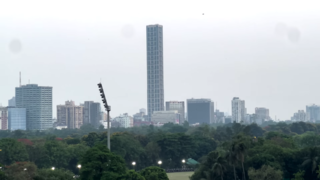
Maidan is a large urban area containing vast urban green space, parks, playgrounds and several public venues in the center of Kolkata, India. The area is spread over a total area of 1283 Acres. The urban green space of Maidan, which compromises an area of around 400 acres, is the largest urban park and urban green space in Kolkata city and second largest in the Kolkata metropolitan area as well as in India. Prior to 2013, before the creation of Eco Park it was the largest urban park in India. Its vast stretch of field that includes numerous sporting grounds, including the famous cricketing venue Eden Gardens, several football stadiums and the Kolkata Race Course.
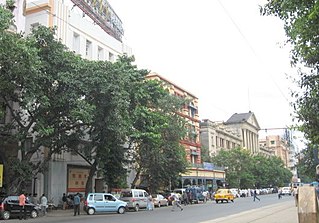
Esplanade is a neighbourhood of Central Kolkata, in Kolkata district in the Indian state of West Bengal. This is not a conventional esplanade in the sense that the place is not exactly situated alongside a waterbody. However, the Ganga river (Ganges), also known as Hooghly river, flows nearby.
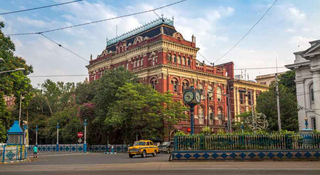
Binoy-Badal-Dinesh Bagh, shortened as B. B. D. Bagh, formerly called Tank Square and then Dalhousie Square, is the administrative, financial and commercial region and one of the central business districts of Kolkata, capital of the Indian state of West Bengal. It is the seat of Government of West Bengal and houses all three branches of it. The area consists Writers' Building, the official state secretariat building, Raj Bhavan, the residence of Governor of West Bengal, Vidhansabha Bhavan, the building housing the West Bengal Legislative Assembly and also the Calcutta High Court.

Kolkata is located in the eastern part of India. It has spread linearly along the banks of the Hooghly River. The Kolkata Municipal Corporation has an area of 205 square kilometres. The city is near sea level, with the average elevation being 17 feet. The whole area is in the Ganges Delta which starts within 100 km south of the city. Most of the city was originally marshy wetlands, remnants of which can still be found especially towards the eastern parts of the city.

Chowringhee is a neighbourhood of Central Kolkata, in Kolkata district in the Indian state of West Bengal. Chowringhee Road runs on its western side. A neighbourhood steeped in history, it is a business district, as well as a shopper's destination and entertainment-hotel centre. The area lies exactly at the centre of the city.

Bengal was a directorate of the Dutch East India Company in Mughal Bengal between 1610 until the company's liquidation in 1800. It then became a colony of the Kingdom of the Netherlands until 1825, when it was relinquished to the British according to the Anglo-Dutch Treaty of 1824. Dutch presence in the region started by the establishment of a trading post at Pipili in the mouth of Subarnarekha River in Odisha. The former colony is part of what is today called Dutch India. Bengal was the source of 50% of the textiles and 80% of the raw silk imported from Asia by the Dutch.

Kalikata was one of the three villages which were merged to form the city of Kolkata in India. The other two villages were Gobindapur and Sutanuti. Job Charnock, an administrator with the British East India Company is traditionally credited with the honour of founding the city. He settled in the village of Sutanuti.

Gobindapur was one of the three villages which were merged to form the city of Calcutta in late 17th century. The other two villages were Kalikata and Sutanuti. Job Charnock, an administrator with the British East India Company is traditionally credited with the honour of founding the city. While Kalikata and Sutanuti lost their identity as the city grew, Gobindapur was demolished for the construction of new Fort William.
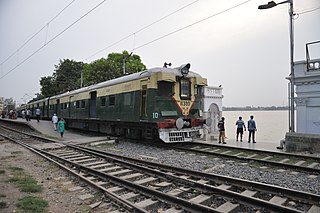
Kolkata Circular Railway, also known as the Kolkata Chakra Rail, is a 36.20 km (22.49 mi) long railway loop line operated by the Sealdah division of the Eastern Railway zone of Indian Railways, encircling the city of Kolkata.
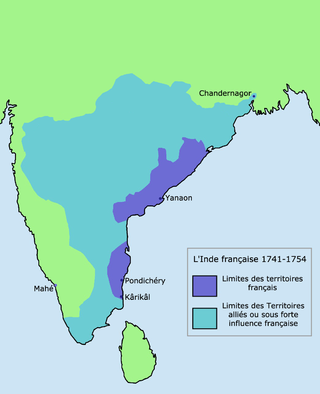
The siege of Calcutta was a battle between the Bengal Subah and the British East India Company on 20 June 1756. The Nawab of Bengal, Siraj ud-Daulah, aimed to seize Calcutta to punish the company for the unauthorised construction of fortifications at Fort William. Siraj ud-Daulah caught the Company unprepared and won a decisive victory.

The Munger Fort, located at Munger, in the state of Bihar, India, is built on a rocky hillock on the south bank of the Ganges River. Its history is not completely dated but it is believed that it was built during the early rule of Slave dynasty of India. The Munger town where the fort is situated was under the control of Muhammad bin Tughluq of Delhi. The fort has two prominent hills called the Karnachaura or Karanchaura, and the other a built up rectangular mound deduced to be the location of a citadel of the fort with historical links. The fort had a succession of Muslim rulers (Khaljis, Tughlaqs, Lodis, Nawabs of Bengal, followed by Mughal rulers, till it was finally acceded to the British by Mir Quasim, after unseating his father-in-law Mīr Jafar on the grounds of old age, for a monetary reward negotiated by Vansittart. This deal involved payment by the East India Company's merchants of an ad valorem duty of 9 percent, against an Indian merchant's duty of 40%. The fort became a place of considerable importance to the British in Bengal till 1947.
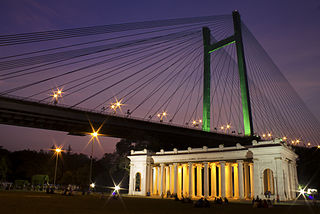
Prinsep Ghat is a ghat built in 1841 during the British Raj, along the Kolkata bank of the Hooghly River in India. The Palladian porch in the memory of the eminent Anglo-Indian scholar and antiquary James Prinsep was designed by W. Fitzgerald and constructed in 1843.

Sealdah railway division is one of the four railway divisions under the Eastern Railway zone of the Indian Railways. Its headquarters is located in Kaiser Street in Kolkata, West Bengal near the Sealdah railway station. Geographically the division covers the railway tracks and services in the areas between the Hooghly river on the west, Bangladesh on the north and east and the Sundarbans in the south.

Hastings is a neighbourhood of Central Kolkata in Kolkata district in the Indian state of West Bengal.

